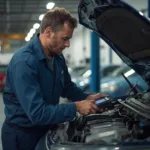The OBD2 system in your car is a powerful tool for diagnosing engine problems. While it doesn’t directly measure fuel pressure, it uses clever workarounds to determine if your fuel system is operating within the proper range. This article dives into how your car’s OBD2 system uses various sensor readings to assess fuel pressure and identify potential issues.
One critical sensor is the Manifold Absolute Pressure (MAP) sensor. The MAP sensor measures the pressure inside the intake manifold, which is directly influenced by the amount of air and fuel being drawn into the engine. When the engine is running, the OBD2 system compares the MAP sensor readings to pre-programmed values. If the readings are outside the expected range, it could indicate a fuel pressure problem. For instance, unusually low MAP sensor values might suggest inadequate fuel pressure, as insufficient fuel would result in lower pressure within the intake manifold.
Another vital sensor in this process is the Oxygen (O2) sensor, which monitors the oxygen content in the exhaust gases. This information helps the OBD2 system determine if the engine is running lean (too much air, not enough fuel) or rich (too much fuel, not enough air). A lean condition could indicate high fuel pressure, while a rich condition might suggest low fuel pressure. By analyzing the O2 sensor data, the OBD2 system indirectly assesses fuel pressure and identifies potential deviations from the norm.
The Engine Coolant Temperature (ECT) sensor also plays a role. Fuel pressure can be affected by temperature, and the OBD2 system uses the ECT sensor data to adjust its fuel pressure expectations accordingly. For example, a cold engine requires a richer fuel mixture, so the OBD2 system anticipates higher fuel pressure during cold starts.
Furthermore, the Throttle Position Sensor (TPS) contributes to the fuel pressure assessment. The TPS relays information about the position of the throttle plate, which dictates the amount of air entering the engine. As the throttle opens wider, demanding more power, the OBD2 system expects a corresponding increase in fuel pressure to maintain the optimal air-fuel mixture. Significant deviations from these expected values could trigger an OBD2 code related to fuel pressure.
While the OBD2 system doesn’t directly measure fuel pressure, it utilizes a network of sensors and sophisticated algorithms to infer its status. By monitoring the MAP, O2, ECT, and TPS sensors, among others, the system can indirectly assess fuel pressure and detect potential issues. If a problem is identified, the OBD2 system will store a corresponding code, providing valuable insights for mechanics to diagnose and repair the underlying cause effectively.
FAQs:
-
Can I check fuel pressure with an OBD2 scanner?
While most standard OBD2 scanners won’t display fuel pressure directly, some advanced models offer this functionality. -
What OBD2 code indicates a fuel pressure problem?
Several codes can relate to fuel pressure, including P0087 (Fuel Rail/System Pressure – Too Low), P0088 (Fuel Rail/System Pressure – Too High), and others. -
What are the symptoms of low fuel pressure?
Common symptoms include engine hesitation, sputtering, rough idling, difficulty starting, and reduced engine performance. -
Can a bad fuel pump cause low fuel pressure?
Yes, a failing fuel pump is a common cause of low fuel pressure. Other potential culprits include a clogged fuel filter, faulty fuel pressure regulator, or leaking fuel lines. -
How do I fix a fuel pressure problem?
Diagnosing and repairing fuel pressure issues requires specialized knowledge and tools. It’s recommended to consult a qualified mechanic for accurate diagnosis and repair.
Need More Help?
For additional information on OBD2 codes and troubleshooting, check out these resources:
- Audi A4 2.0T 2006 OBD2 P0455 Code
- EPA OBD2
- Cobb OBD2 Cable
- P0128 OBD2 Code Add Coolant
- What Does 10 in hg Mean Regarding Map on OBD2
If you require further assistance or have specific questions about your vehicle, our team of automotive experts is here to help. Contact us via WhatsApp at +1(641)206-8880 or email us at [email protected]. We offer 24/7 customer support to address your automotive concerns.

